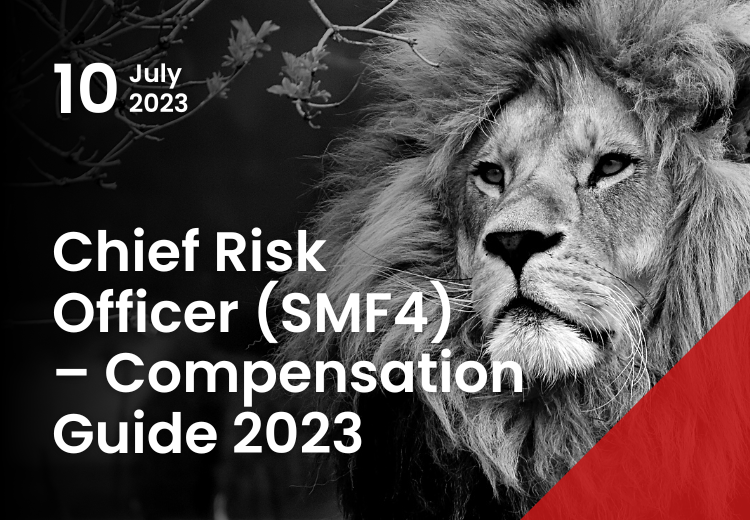
Chief Risk Officer (SMF4) Compensation Guide – SME Financial Services
About the Author
James Sayer is Managing Partner at Sayer Haworth Executive Search. For over 20 years, having lived and worked in the UK, Europe and the Middle East, James has acted as a trusted business partner to source senior leaders within Financial Services
Executive Summary
- The Chief Risk Officer compensation has increased due to the increased regulatory scrutiny under the Senior Managers Regime. Packages are very much dependent on the category of the firm, there is a variance between the categories, this survey is based on Category 2 to Category 5 firms
- With the increased number of new entrants into the market, there is a general consensus that demand is higher than the available talent in the market
- Recent Searches that Sayer Haworth have completed have revealed a 22% Female, 78% male split on gender diversity within the SMF4 position
- A high demand for CRO’s that have commercial lending experience
- Average base salaries are between £175,000 –£250,000, dependant on the Category of the firm
Who are SME Financial Services
Sayer Haworth is a Boutique Executive Search & Advisory firm focused purely on Small to Medium Financial Services companies. Our focus on this segment enables us to bring an unrivalled network, market knowledge and understanding. The business that form this segment and covered in this report are Building Societies, Challenger Banks, Foreign Subsidiary Banks and New Start-up Banks.
A detailed look at Chief Risk Officer compensation
With the increase of regulation under the Senior Managers Regime, executive pay has come under upwards pressure within Financial Services since the 2008 Financial Crisis, the makeup of reward to senior executives can be complex. This white paper has been written to provide a broad compensation guide for a Chief Risk Officer within a Small to Medium sized bank in the UK.
Pay Structure
The Chief Risk Officer compensation generally comprises of base salary, annual bonus, long-term incentive scheme and pension. There may be other non-cash related benefits which are detailed in this report.
We have seen a rise in organisations offering flexible benefits, where employees can elect to use this allowance to purchase benefits, or the employee can be paid this amount in a cash equivalent.
Chief Risk Officer Salary Range
The general range of a base salary for a Chief Risk Officer is between £175,000 – 250,000.
The salary, in our findings, forms the largest part of the remuneration for the Chief Risk Officer.
Base salaries on offer at the lower end of this scale were firms that generally have a branch operation in the UK, typically a low category firm, and not a full subsidiary; these banks would have on average 25 –50 employees. The median base salary for Chief Risk Officers is within this segment is £180,000.
At the higher end of the base salary scale, this would be banks that are full subsidiaries or building societies in the UK, the number of employees would be over 250. The median base salary for the Chief Risk Officer in this segment is £225,000.
Short Term Incentives (Annual Bonus)
With the introduction of the PRA and FCA remuneration rules, bonuses are capped at 100% of base salary, or up to 200% with shareholder approval. All the Chief Risk Officers in our research were eligible for a bonus, we did not find any Chief Risk Officer who did not achieve their annual bonus award.
The average bonus payments were from 35 –62% of base salary.
Pension
The pension arrangements for the Chief Risk officer is an average non-contributory range of 9 – 15%, the survey revealed that the majority of the Chief Risk Officers that we researched had reached their lifetime allowance to contribute into a pension scheme.
Therefore the common practice was for the individual to receive the cash equivalent in contributions in their normal salary which they would then pay standard income tax of this.
Benefits
The benefits offered formed the lowest element of the package, typically on offer were the following:
- Healthcare Insurance, individual and dependents (occasionally dental and optical included)
- Life Insurance (Average from 4 –6 times annual salary)
- Critical Illness Cover (Varys, depending on the Firms policy)
- Gym Membership
- Flexible Benefits (Child Care Vouchers, Gym Membership, Cycle to Work)
- Holidays (28 –30 Days)
Senior Managers Regime (SMCR)
The Chief Risk Officer is now very much held to account for the actions of their firm under the Senior Managers Regime, the SMF 4, is regarded as one of the high risk roles under this regime due to the responsibilities of the role.
The role typically incorporates Credit Risk, Operational Risk, Market Risk, in addition depending on the size of the firm, the smaller firms also include Compliance and Financial Crime under the Chief Risk Officer. These areas of responsibility make the Chief Risk Officer a significant Material Risk Taker (MRT) in a firm.
Senior managers are responsible for certifying annually that a wide swath of staff are “fit and proper to perform their role.” This includes anyone who could potentially harm the public or the firm, as well as those who are high-earners or handle client money.
With this increased responsibility for a Chief Risk Officer, there is a consensus that there also needs to be a financial package that reflects the increased responsibility and consequences of falling foul of the regulator. A Chief Risk Officer may not intentionally be aware of an action in the Bank that results in breach, however, under SMCR, they are now responsible and would need to demonstrate reasonable steps they had taken to reduce the risk of a breach.
Attraction and Retention
At this level of the organisation, the Chief Risk Officer is generally looking at the content and the challenge ahead. As in every case, and this is not unknown, the right package has to be on offer to attract and retain Chief Risk Officers in their roles.
The Chief Risk Officer under the Senior Managers Regime expects to have full accountability and veto rights within their role. A common reason why a Chief Risk Officer wishes to move on from their role is due to frustration of not having the resource to be able to ensure that the appropriate level of cover is in place under the Senior Managers Regime. More recently, compensation is starting to become an increasing reason for Chief Risk Officers wishing to make a move.
Compensation levels have increased at pace since the Senior Managers Regime has become more established.
Diversity
Sayer Haworth have found there is a shortfall in gender diversity within the Chief Risk Officer (SMF4) position within SME Financial Services Companies. Two recent searches have revealed an average of 22% Female and 78% male profiles. This population includes profiles that are not holding the CRO position today, providing insights into the succession planning within the sector today and further focus needed within organisations to address this significant in-balance.
Sayer Haworth is a member of the Women in Finance Charter, promoting gender diversity within our shortlists. We understand the importance of developing and maintaining an inclusive business culture. Sayer Haworth is committed to Diversity & Inclusion and partners with clients in attracting a diverse talent pool in our searches, understanding that employee engagement is higher in those organisations that have a clear strategy.

Product Experience – Commercial Lending
There have been a number of new banking entrants into the market, with a focus on commercial lending. This has resulted in a high demand for Chief Risk Officers to have experience within the commercial lending space, particularly to SME’s.
In addition to the new entrants, existing business that were mainly retail lending focused are looking to diversify into Commercial Lending in the UK, where the margins achieved are greater.
As we are in the middle of a cost of living crisis with high inflation, there is a focus on the current book of business that is going through challenging times. Sayer Haworth have experienced requests that individuals have been through at least one economic downturn to ensure that the business is prepared.
Summary
Our insights in this subject have revealed that the majority of Chief Risk Officers are happy with their compensation level, they find it fair and reflective for the responsibilities they have.
We have found that what is missing, is the non-financial elements that can be offered to a Chief Risk Officer, this is in the form of personal development opportunities.
There is work to be done in achieving a higher level of gender diversity within the Chief Risk Officer position within firms.
The general demand for a Chief Risk Officer is high in the market, firms that are offering base salaries at the lower end of the guide base salary do find it a challenge to retain or secure talent.
Sayer Haworth Executive Search Contacts:
James Sayer – Managing Partner
 James has been within Executive Search in the Financial Services sector for over 20 years, having lived and worked in the UK, Europe and the Middle East. James has acted as a trusted business partner to source Board and Executive talent within SME Banks. James focuses on forming long-term partnerships with his clients in order to offer a truly consultative service built on time investment, integrity and a considered service delivery to generate the right solution.
James has been within Executive Search in the Financial Services sector for over 20 years, having lived and worked in the UK, Europe and the Middle East. James has acted as a trusted business partner to source Board and Executive talent within SME Banks. James focuses on forming long-term partnerships with his clients in order to offer a truly consultative service built on time investment, integrity and a considered service delivery to generate the right solution.
Email: jamessayer@sayerhaworth.com
Tel: +44 (0) 203 751 6260
Mob: +44 (0) 7951 966 0777
Andrea Mynard – Practice Leader
 Andrea has worked in the sector for more than 20 years. Andrea delivers a uniquely personalised service – focusing on understanding a client’s needs and matching requirements with a tailored search including market mapping, identification of talent, engagement and screening.
Andrea has worked in the sector for more than 20 years. Andrea delivers a uniquely personalised service – focusing on understanding a client’s needs and matching requirements with a tailored search including market mapping, identification of talent, engagement and screening.
Email: andreamynard@sayerhaworth.com
Tel: +44 (0) 203 751 6260
Mob: +44 (0) 7712 877 384
To download this article please click here
